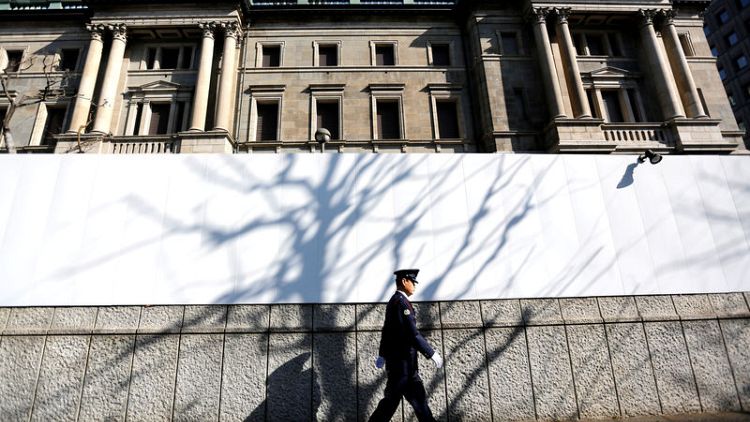By Leika Kihara
TOKYO (Reuters) - The Bank of Japan faces its first test on Tuesday in keeping up with its increasingly dovish U.S. and European peers, as the growing pain from soft global demand and trade tensions weigh on the country's modest economic recovery.
With solid domestic demand in Japan helping to offset weak exports, many BOJ officials see no imminent need to roll out more stimulus, preferring to save their limited ammunition in case economic conditions deteriorate, sources familiar with its thinking have said.
The European Central Bank's decision last week to hold off on immediate policy easing gave the BOJ some breathing space and heightened the chance of no action at its two-day rate review that ends on Tuesday, analysts say.
In another sign of relief for BOJ officials, the yen remains stable even as markets fully price in a 25-basis-point interest rate cut by the U.S. Federal Reserve later this week. It will announce its policy decision a day after the BOJ's meeting.
"Markets are already pricing in a 100% chance of a Fed rate cut, so (the Fed's decision) is unlikely to trigger an abrupt yen rise," said Junichi Makino, chief economist at SMBC Nikko Securities, who expects the BOJ to hold policy steady.
The market consensus is for the BOJ to maintain a pledge to guide short-term interest rates at -0.1% and the 10-year bond yield around 0% via aggressive bond purchases.
But not all investors are convinced the BOJ meeting will be a non-event. Some believe it may tweak its forward guidance - a pledge central banks make on future monetary policy moves - and commit to keeping rates ultra-low over a longer-term horizon.
At present, the BOJ commits to maintaining rates at current extremely low levels "for an extended period of time, at least through around spring 2020."
However, some in the BOJ worry that seeking to appease markets by tinkering with the wording could backfire and push up the yen, if it is seen as a sign of desperation, sources have told Reuters.
Other analysts warn that by failing to act, the BOJ may come under fire if stock prices tank and investors rush into the safe haven yen.
After Tuesday's meeting, the BOJ does not have a scheduled rate review until Sept. 18-19.
"The BOJ must weigh the merits of waiting until September against the risk of stock price falls triggering a potential yen rise," said Tomoyuki Shimoda, a former BOJ official who is now an economics professor at Japan's Hitotsubashi University.
"The BOJ will take some form of easing measures in July to prevent markets from formulating the view it is lagging behind the Fed and the ECB in the race to the bottom."
The BOJ faces a dilemma. Years of near-zero rates have hurt financial institutions' profits by narrowing their margin, while the BOJ's aggressive buying has dried up bond market liquidity.
That has left the BOJ with little ammunition to fight the next recession, let alone ramp up steps to accelerate inflation to its elusive 2% target.
Japan's annual core consumer inflation stood at 0.6% in June, the slowest pace in about two years.
In fresh quarterly projections to be issued at Tuesday's meeting, the BOJ will likely trim its inflation forecast for the current fiscal year ending in March 2020, sources say.
Clouds are also hanging over the BOJ's projection that global growth will rebound in time to make up for an expected hit to consumption from a nationwide sales tax hike in October.
(Reporting by Leika Kihara; Editing by Kim Coghill)



